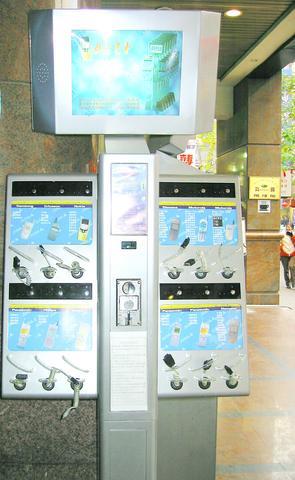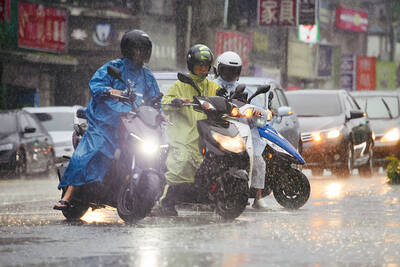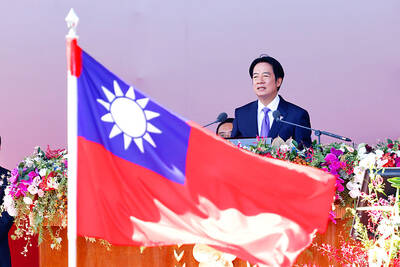Over the last two years, Genevieve Bell, an anthropologist employed by Intel Research, has visited 100 households in 19 cities in seven countries in Asia and the Pacific to study how people use technology.
Twenty gigabytes of digital photos later -- along with 329,600km, 19 field notebooks, two camera batteries, five umbrellas, three hats, two doses of anti-malarial drugs and one pair of her favorite sandals -- she has come back with some provocative questions about technology, culture and design.

PHOTO: NY TIMES
Some of what she learned in the field will be folded into Intel's design process, passed on to industrial designers and engineers and perhaps eventually embodied in a device. But many of Bell's findings also raise deep questions about the meaning of technology in an interconnected world.
Her fieldwork project began four years ago with the insight that Intel might have a misconception about the potential users of its products elsewhere in the world.
"We thought, there's a group of people just like us all over the world who will buy the technology and have it fill the same values in their lives," Bell said. "I was fairly certain that wasn't going to be the case. I'm an anthropologist. Culture matters."
Bell, 37, who received her doctorate in anthropology from Stanford University with a dissertation on American Indian boarding schools, joined Intel in 1998. She is working on a book for MIT Press about her Asian research.
Bell's project sent her to seven countries: India, China, Singapore, Indonesia, Malaysia, South Korea and Australia. She found that in some places, "It's harder for some forms of technology to get over the threshold of the home" -- not simply for economic reasons but for religious ones as well. For example, she said, values of humility and simplicity may make technology less welcome in some Hindu homes in India or some Muslim homes in Malaysia and Indonesia.
"If part of the value of the home is this space of purity that's protected from the pollutedness of the world, a place where you express values like simplicity, humility, modesty, grace," Bell said, "that becomes a barrier to adopting some technologies."
She also pointed out that most US homes have space for leisure activities, and often that space is private. By contrast, Japan's tighter quarters afford little privacy, which may account for the attraction of young people there to text-messaging over mobile phones.
Even the reliability of power may be an American assumption to be overcome: In Malaysia, power surges caused by monsoons can fry computer motherboards.
Such insights challenged Intel's vision of a world of "smart homes" and a chip-driven lifestyle, Bell said, which assumes that users are secular. In those visions, there's no point at which residents stop to pray, visit a church, or have a moment of internal reflection.
All this prompted her to ask David Tanenhaus, Intel's vice president of research: "What if our vision of ubiquitous computing is so secular, so profoundly embedded in a set of Western discourses, that we've created a vision of the world that shuts out a percentage of people in a way we can't really even begin to articulate?"
Intel is not alone in wanting to know more about values and habits in emerging markets.
"Over the last 18 months we've seen more interest in doing international and intercultural research in design for products," said Mike Kuniavsky, a principal with Adaptive Path, a San Francisco-based consulting firm that works with international clients like Peoplesoft, a major business-software company.
For instance, the South Korean electronics company LG Electronics has introduced a mobile phone with an embedded compass to allow Muslim users to locate the direction of Mecca using Global Positioning System technology.
In the past, marketing teams might have been given the task of making a product cross-culturally palatable. Increasingly, however, culture is taken into account earlier, at the design stage.
For its part, Intel relies on a cycle of design that begins with high-level prognostication about potential markets. Then ethnographers like Bell and market researchers are sent to meet those people. The resulting information is incorporated into portraits of individual users. These portraits, called personas, describe a person's life.
"This personifies something that otherwise looks like an aggregate of people," explained Herman D'Hooge, Intel's innovation strategist, who is in charge of acting on insights like Bell's.
One such "persona" that Bell produced in China describes "Sally Lu," a 25-year-old woman living in Shanghai -- a day in her life, her activities and concerns, her attitudes about technology.
"She thinks that new high-tech products must not be too expensive, and the functions don't need to be too fancy," like cellphones with video screens, the document says. "As long as it fulfills basic functions and is easy to operate, people will like it and buy it.
These personas become tools to help industrial designers and engineers understand how users think about products. The challenge, D'Hooge said, is to keep the element of innovation open for as long as possible in this process. By understanding their users, they hope to produce radically innovative concept devices for little risk.
For Intel, a first iteration of this user-centered design cycle yielded a combination PC-entertainment center for use by people in small living spaces, while the second resulted in a PC-like device intended for Chinese users who could not afford a full-size machine. (This concept device has not yet been released.)
Bell recognizes that translating her ideas into products is difficult.
"These things are interesting as a design brief," she said. "They're really hard as a product challenge."
She said that technology companies like Intel should nevertheless be willing to consider information that challenges the grander visions of technology. This involves challenging some Western cultural assumptions about digital technology.
"I think I would like to imagine that I am doing the thing that all anthropologists do," she said, "asking these harder questions about what is real and true."

The combined effect of the monsoon, the outer rim of Typhoon Fengshen and a low-pressure system is expected to bring significant rainfall this week to various parts of the nation, the Central Weather Administration (CWA) said. The heaviest rain is expected to occur today and tomorrow, with torrential rain expected in Keelung’s north coast, Yilan and the mountainous regions of Taipei and New Taipei City, the CWA said. Rivers could rise rapidly, and residents should stay away from riverbanks and avoid going to the mountains or engaging in water activities, it said. Scattered showers are expected today in central and

People can preregister to receive their NT$10,000 (US$325) cash distributed from the central government on Nov. 5 after President William Lai (賴清德) yesterday signed the Special Budget for Strengthening Economic, Social and National Security Resilience, the Executive Yuan told a news conference last night. The special budget, passed by the Legislative Yuan on Friday last week with a cash handout budget of NT$236 billion, was officially submitted to the Executive Yuan and the Presidential Office yesterday afternoon. People can register through the official Web site at https://10000.gov.tw to have the funds deposited into their bank accounts, withdraw the funds at automated teller

COOPERATION: Taiwan is aligning closely with US strategic objectives on various matters, including China’s rare earths restrictions, the Ministry of Foreign Affairs said Taiwan could deal with China’s tightened export controls on rare earth metals by turning to “urban mining,” a researcher said yesterday. Rare earth metals, which are used in semiconductors and other electronic components, could be recovered from industrial or electronic waste to reduce reliance on imports, National Cheng Kung University Department of Resources Engineering professor Lee Cheng-han (李政翰) said. Despite their name, rare earth elements are not actually rare — their abundance in the Earth’s crust is relatively high, but they are dispersed, making extraction and refining energy-intensive and environmentally damaging, he said, adding that many countries have opted to

PEACE AND STABILITY: Maintaining the cross-strait ‘status quo’ has long been the government’s position, the Ministry of Foreign Affairs said Taiwan is committed to maintaining the cross-strait “status quo” and seeks no escalation of tensions, the Ministry of Foreign Affairs (MOFA) said yesterday, rebutting a Time magazine opinion piece that described President William Lai (賴清德) as a “reckless leader.” The article, titled “The US Must Beware of Taiwan’s Reckless Leader,” was written by Lyle Goldstein, director of the Asia Program at the Washington-based Defense Priorities think tank. Goldstein wrote that Taiwan is “the world’s most dangerous flashpoint” amid ongoing conflicts in the Middle East and Russia’s invasion of Ukraine. He said that the situation in the Taiwan Strait has become less stable